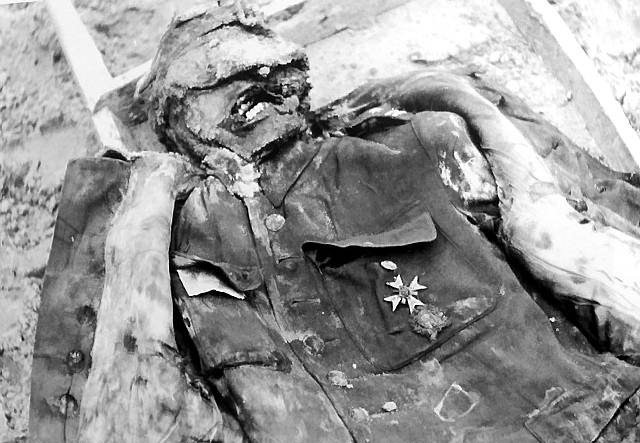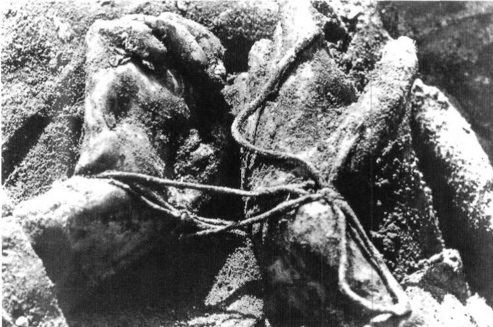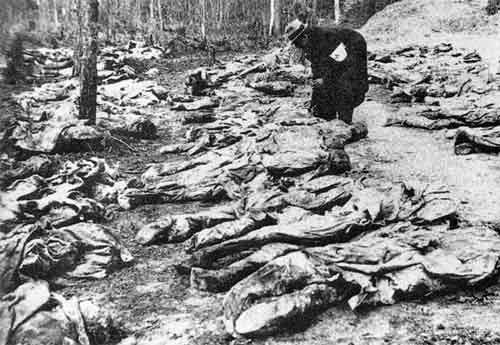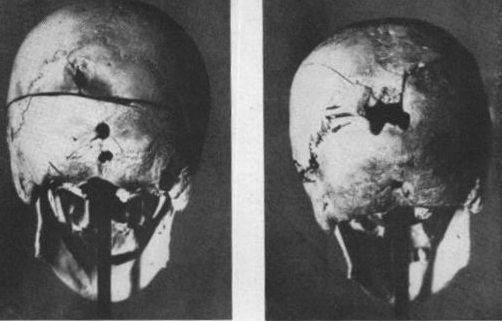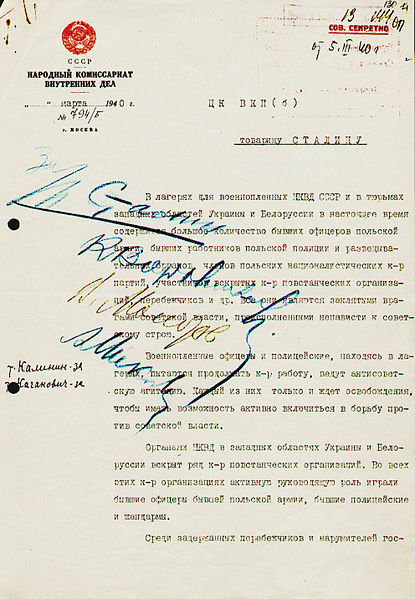Holocaust Education & Archive Research Team |
Occupation German Occupation of Europe Timeline
-
[The Occupied Nations]
Poland Austria Belgium Bulgaria Denmark France Germany Greece Hungary Italy Luxembourg The Netherlands Norway Romania Slovakia Soviet Union Sudetenland | ||||||||||
Mass murder in the forests of Katyn
The first news of strange and terrible happenings at Katyn was broadcast by Radio Berlin on 13 April 1943.
A report has reached us from Smolensk to the effect that the local inhabitants have mentioned to the German authorities the existence of a place where mass executions have been carried out by the Bolsheviks and where 10,000 Polish officers have been murdered by the Soviet Secret State Police.
The German authorities accordingly went to a place called the Hill of Goats (Kozogory), a Russian health resort situated 12 kilometres west of Smolensk, where a gruesome discovery was made.
A ditch was found, 28 metres long and 16 metres wide, in which the bodies of 3,000 Polish officers were piled up in twelve layers. They were fully dressed in military uniforms, some were bound, and all had pistol shot wounds in the back of their heads. There will be no difficulty in identifying the bodies as, owing to the nature of the ground, they are in a state of mummification and the Russians had left on the bodies their personal documents.
It has been stated today that General Smorawinsky from Lublin has been found among other murdered officers. Previously these officers were in a camp at Kozelsk near Orel and in February and March 1940 were brought in “cattle” freight cars to Smolensk. Thence they were taken in lorries to the Hill of Goats and murdered there by the Bolsheviks. The search for further pits is in progress. New layers may be found under those already discovered.
It is estimated that the total number of officers killed amounts to 10,000, which would correspond to the entire cadre of Polish officers taken prisoner by the Russians.
As it came from Dr Goebbels’ Propaganda Ministry, this communiqué was automatically suspect. On the other hand, the history of Soviet- Polish relationship since 1939 had been such that the story could not be lightly dismissed.
On 1 September 1939, when the German armies invaded Poland, she and the Soviet Union were bound by a number of seemingly unbreakable treaties and agreements. But in the dawn of 17 September 1939, at a time when Poland was most hard pressed by her German aggressors, the Red Army crossed the Polish frontier in considerable force – ostensibly, ‘to take all measures to extricate the Polish people from the unfortunate war into which they were dragged by their unwise leaders and to enable them to lead a peaceful life.’
During the next days the closeness of the collaboration between Germany and Russia became apparent. Poland was formally partitioned on 28 September and, in the hope of ending the bitter fighting, a manifesto was issued by the Russian General Timoschenko exhorting the soldiers of the Polish army to turn upon their officers and surrender.
In return for laying down their arms, all Polish prisoners of war were guaranteed complete freedom of movement and it was promised they would be permitted to make their way to Rumania and Hungary en route for France, where they could continue to fight the Germans.
This promise was not kept. Polish NCO’s with technical qualifications and all officers were deported from Poland to Russia and accommodated in three main camps: Kozelsk, Starobelsk and Ostashkov. In the late autumn of 1939, letters from them began to reach their families left behind in Poland.
Kozelsk is situated some 250 kilometres south-east of Smolensk on the site of a former monastery. It accommodated about 5,000 persons at the end of November 1939. The saying of Mass, very dear to the Polish heart, was strictly forbidden by the Soviet authorities but continued in secret. It is significant that all the priests – with one exception – were removed from the camp just before Christmas. Most of them disappeared without trace.
When the final winding up of the camp began in April 1940, it held the following Polish prisoners: four generals, and one rear-admiral; approximately 100 colonels and lieutenant –colonels; 300 majors, 1,000 captains, 2,500 1st and 2nd lieutenants and more than 500 officer cadets: 200 air force and 50 naval officers.
Officers of the reserve formed about 500 of the groups and among them were 21 university professors and dons, more than 300 surgeons and physicians, many of them renowned specialists; several hundred judges, barristers, solicitors, and court officials; several hundred skilled engineers, teachers and lecturers; many writers, poets journalists, industrialists, and prominent businessmen.
There is also a record of one woman prisoner in Kozelsk. Her name was Madam Janina Lewandowski and she wore a Polish air force uniform. Her body was found among those of her comrades at Katyn in April 1943.
Starobelsk is a small township in the Soviet Ukraine. Between November 1939 and April 1940, this camp – also on the site of a former monastery – contained about 4,000 senior and junior officers, both active and reserve.
Ostashkov, yet again an old monastery, stood on an island in Lake Seliger to the north-west of Kalinin. The camp held 6,000 prisoners who were classified as being ‘bourgeois’ – and therefore dangerous to a country where the bourgeois have no place in the social system.
In spite of the magnitude of the Polish military disaster, the mood of the prisoners held in all these camps was optimistic. This optimism was based on the sure belief that the Germans could not prevail against the mounting might of the Western Allies.
The ‘re-education’ of the Polish prisoners was attempted by a Brigadier Zarubin and his team of Soviet Secret State Police. Every prisoner was personally interrogated and the most minute details were recorded. Soviet propaganda was broadcast incessantly and all three camps were plastered with posters.
It is fair to say that Brigadier Zarubin did his best to improve the living conditions of the prisoners in the first weeks of their captivity. But it became plain that the Polish officers would never accept the Soviet way of life. Their intellectual interests were utterly different from those of the Russians and their adherence to Christian principles remained ardent and unshakeable. It is probable that Brigadier Zarubin had to report the failure of his efforts at ‘re-education’ to the highest authorities in Moscow. Certain it is that a colonel of the Soviet Secret State Police turned up at all three camps shortly before groups of prisoners were taken away to what was then an unknown destination.
In the first days of April 1940, the final clearing of all three camps began simultaneously. About 400 of the 15,000 prisoners were transported to a new camp at Pavlishchef Bor and it is from these survivors that the Polish military authorities later were given the fullest information about living conditions in the camps. But from their comrades who had shared these conditions no further word was ever heard. Their silence was final and absolute.
When Germany attacked the Soviet Union on 22 June 1941, her armies penetrated deeply into Russia and Stalin had perforce to call upon those very allies whose destruction he had plotted with Hitler. A so-called ‘amnesty’ was granted to all Poles held for one reason or another, who should immediately form a Polish army to fight with the Russians against the common foe. On 14 August 1941, a Polish – Soviet military agreement was signed. Winston Churchill wrote:
General Anders and other Polish generals, who had hitherto been confined under rigorous conditions, including beatings, in Russian prisons , were now washed, clothed, released, welcomed and given high commands in the Polish forces.
The Poles who had long been anxious about the fate of the large group of officers in three internment camps (Kozelsk, Starobelsk, and Ostashkov) asked for their release. But no one from the three camps, now in German throes, could ever be found. Polish leaders were conscious of numerous occasions of embarrassment on the part of Russian officials.
In the course of urgent Polish enquiries as to the whereabouts of the missing prisoners, General Anders brought up the matter on two occasions during conversations with Stalin in the presence of Molotov. On the first occasion Stalin indicated that the prisoners might have escaped to Manchuria. This left General Anders with the belief that they were still alive although widely dispersed. During a second enquiry, Stalin indicated the line which the Russians were to take in the event of the prisoners ever being found. His words were: ‘It may be that they were in camps in territories which have been taken over by the Germans.’
An even more sinister note was struck during a conversation between Lieutenant- Colonel Z.Berling of the Polish General Staff and M. Merkulov, deputy head of the Soviet Secret Police in the presence of Commissar Beira, then head of the Soviet Secret State Police. Lieutenant –Colonel Berling remarked that there were excellent cadres for the new Polish army at the camps of Starobelsk and Kozelsk. Merkulov blurted out: ‘No, not those. We made a great mistake with them.’
This revealing comment gave rise to the greatest foreboding at General Anders headquarters. Polish misgivings proved to be only too fully justified when the mass graves were discovered.
The Hill of Goats rises in the Katyn forest through which the River Dniepr flows, and had long been known locally as a place of execution for those who opposed or in some way displeased the Stalinist government. As early as 1929, the Soviet Secret State Police had built a dacha (villa) by the bank of the Dniepr, thrown a barbed wire fence around the area , and set up a wooden screen alongside the road to Vitebsk. Having a very shrewd idea what went on in the prohibited forest, the peasants from the surrounding fields used a saying among themselves: ‘Keep mum or they will take you to the Hill of Goats.’ Sometimes the young and daring crawled under the barbed wire to collect the mushrooms which grew there in profusion, but this practice soon stopped when it was seen that armed men with dogs from the dacha were in constant patrol.
The finding of the mass graves came about in this way. The Germans advanced along the left bank of the Dniepr, and Smolensk fell on 16 July 1941. The Russians had fled from Katyn and for the first time for many years the forest was open: there was complete disorder for several days and if anybody had been alive in the forest he could have readily sought his own freedom. Later a German officer set up his headquarters in the dacha and a detachment of German Field Security Police under the command of a Lieutenant Voss, came to Smolensk.
In the spring of 1942, numbers of Poles employed by the Organisation Todt arri9ved, their work was to pick up scrap, and they ‘camped’ in deserted railway carriages near Smolensk. During their slow wanderings up and down the line searching for scrap, the Poles must have heard certain rumours. This must be the reason for their penetration into Katyn Forest in the autumn and for their close examination of the ground at the Hill of Goats. They dug up at least one officer wearing the unmistakeable uniform of their country and re-buried him with reverence, setting up a birch cross over his grave, and another birch cross over a suspicious- looking mound nearby, the sides of which were beginning to crumble. Then the winter set in with severity, the ground froze and hardened, and further digging became impossible.
In the early spring of 1943 a local Russian peasant named Ivan Krivozertzev happened to notice in a Russian language propaganda newspaper – Novy Put that General Silkorski had organised a Polish army in Russia and that the general despite incessant enquiries, could find no trace of some thousands of his officers who were known to have been prisoners of the Soviets in 1939. All news of them had ceased in April 1940. Ivan Kirvozertzev was a devout man and his conscience was troubled by the memory of what he had seen during the whole of that very month.
Sealed railway wagons had then arrived daily in Smolensk and had been shunted into screened sidings at Gniezdovo station. The occupants had been hustled into ‘Black Ravens’ – prison motor coaches corresponding to the English Black Maria – and driven under strong Soviet Secret State Police escort along the main road towards Vitebsk, stopping when they reached Katyn Forest.
Ivan Krivozertzev also remembered that in March he had seen ordinary prisoners from Smolensk being driven to the Hill of Goats in open trucks carrying pickaxes and spades ‘to dig big deep trenches.’ He could not fail to link these two happenings to the item in the newspaper and went to Lieutenant Voss’s interpreter at the office of the German Field Security Police in Gniezdovo. He said tentatively: ‘Silkorski is looking for his officers in Siberia but they lie here, shot at the Hill of Goats.’
At long last the secret was out. Late in February 1943, the Germans under Lieutenant Voss went to the Hill of Goats – also with pickaxes and spades. A peasant named Kisslev, who lived in the forest, indicated where they should start to dig. It was seen at once that the mounds were not in character with the rest of the terrain and that the young fir trees on top of the graves were of a growth to prove to botanists the exact date of their transplantation to this place – April 1940.
Digging began, and during the next few days several score of bodies were exhumed. All of them had been shot in the back of the neck and in a great many cases their hands had been tied behind their backs. The way in which the ropes were knotted and tied was as revealing as the fir trees. In the course of their search the Germans also found the bodies of Soviet civilians, both men and women, who had been executed long before 1940. Their hands were tied with identical ropes and in an identical way.
Utterly conclusive were the documents found on the bodies. They proved beyond any shadow of doubt that these were the missing officers from Kozelsk. The scene at the Hill of Goats was macabre in the extreme. The presence of the body of one woman among this mass of murdered men struck a new note of horror. She was identified as being Madame Janina Lewandowski, late of Kozelsk.
With a fine disregard of Auschwitz, Treblinka and Belzec and similar camps within Hitler’s Reich, the Germans gave the discovery the widest publicity, heavily lacing their reports with moral indignation. They finally gave the number of corpses found at Katyn as 12,000. This figure is based on the known cadre of Polish officers and is inaccurate. Some 4,500 were exhumed and all of these came from Kozelsk. Other than a few hundred known to have survived, there was no trace of the officers from Starobelsk or from Ostashkov. Their whereabouts remains a mystery to this present day.
The Radio Berlin broadcast of 13 April 1943 caused consternation in London. For better or for worse, Russia had become Britain’s ally and private feelings had to be suppressed. There was a feverish silence during 14 April while Moscow’s comments were awaited. Then the Soviet official agency Tass announced as a well known and accepted fact:
The Polish prisoners in question were interned in the vicinity of Smolensk in special camps and were employed in road construction. It was impossible to evacuate them at the time of the approach of the German troops and, as a result, they fell into their hands. If, therefore, they have been found murdered by the Germans who, for reasons of provocation, now claim that the crime was committed by Soviet authorities
It will be remembered that every single Soviet official, from Stalin downwards, had denied all knowledge of these prisoners at all times. In spite of personal misgivings, the British government’s official communiqué was broadcast by the BBC on 15 April 1943:
In a statement broadcast today, Moscow Radio officially and categorically denied the news propounded by the Germans about the alleged shooting of Polish officers by the Soviet authorities. These German lies indicate the fate which met these officers whom the Germans employed in 1941 for construction works in the neighbourhood.
The Polish government in exile in London was aghast at the crime of Katyn and dumbfounded by what it considered the perfidy of the embarrassed British government. The Germans had asked that medical delegations from neutral countries be sent to Katyn freely to investigate on the spot.
The Polish government in exile joined with the Germans in asking that a commission be sent from the International Red Cross in Switzerland. Simultaneously they handed a note to the Soviet ambassador M. Maisky, reiterating their request for detailed and precise information about all the Polish officers who had been in Soviet hands and stating that facts only could refute the fearful allegations made by the Germans. No reply to this note was ever received.
While the neutral professors of forensic medicine were about their grisly work in Katyn Forest, the International Red Cross in Switzerland announced that, while agreeing in principle with the request made by the Polish and German governments for an impartial investigation, the participation of the Soviet government as an interested party ‘was essential.’
The Soviet answer to this invitation was in the nature of a bombshell. Harshly and brutally, the Russians broke off all relations with their Polish allies for ‘aiding and abetting Hitler’ and set up a puppet Polish government in Moscow.
The neutral experts at the Hill of Goats had hardly concluded their investigations and identifications before the distant rumble of advancing Russian guns was heard. The Polish corpses were hastily re-buried and the Germans retreated from the area in some disorder.
The Russians took Smolensk in September 1943 and Katyn with all its secrets was once again in the hands of the Soviets who issued a long statement, claiming categorically that the Polish officers had fallen victim to ‘Hitler’s hangmen.’
At the Nuremburg War Crimes trial, the murder of the Poles at Katyn was mentioned in the indictment of Hermann Goring and others. It was decided by the victorious Allies that the issue should be avoided and the crime at Katyn was never probed.
The Soviet government did not take the opportunity of clearing itself of this horrible and widely believed accusation. In the final judgement of the International Tribunal, Katyn is not mentioned. Everybody is therefore entitled to form his own opinion.
Several years later in September of 1951, the United States House of Representatives established the Select Committee to Conduct an Investigation and Study of the Facts, Evidence, and Circumstances of the Katyn Forest Massacre, known as the Madden Committee after its chairman, Rep. Ray J. Madden of Indiana.
The committee assembled records relating to the massacre and its aftermath, including records from the files of the State and War Departments, in addition to hearing extensive witness testimony. Their purpose was to determine which nation was responsible for the atrocities and whether any American officials had engaged in covering up the massacre.
In addition, the committee found that American policy toward the Soviet Union might have been different if information deliberately withheld from the public had been made available sooner.
Sources:
Russian Federation National Archives Katyn Memorial Museum National Archives of Poland NARA PRO
Copyright Chris Webb and Michael Simons H.E.A.R.T 2013
|







